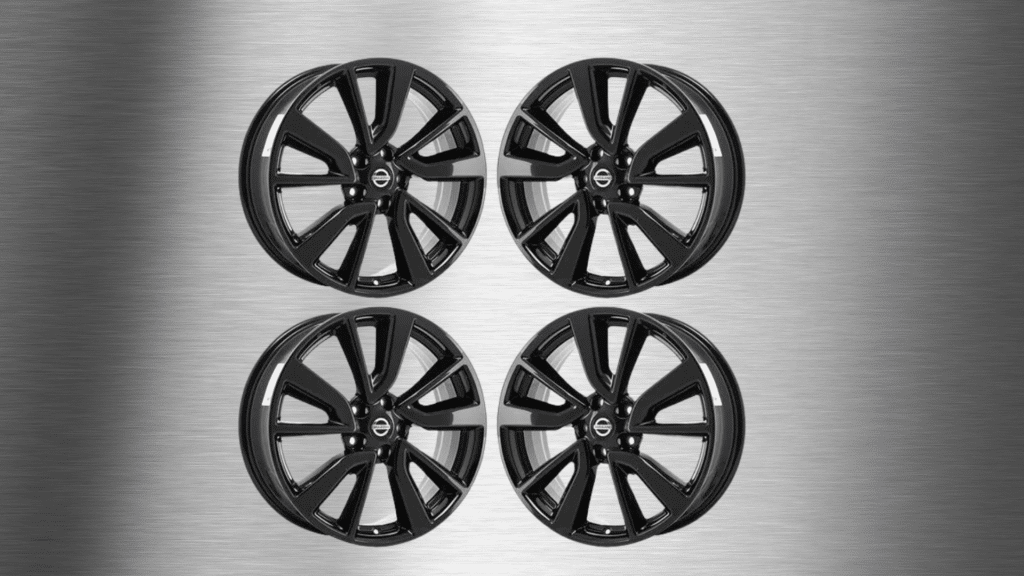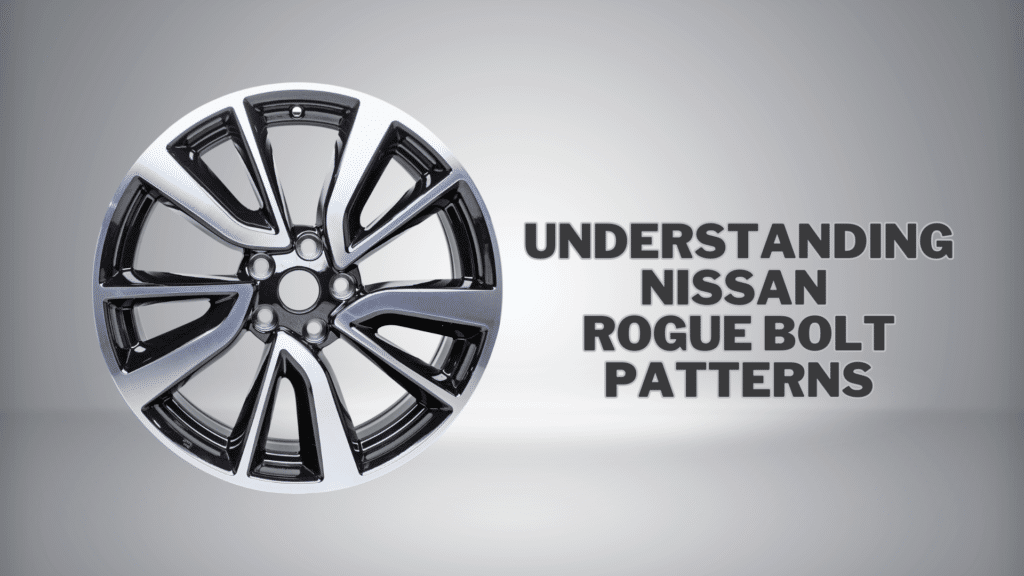When upgrading or replacing the wheels on your Nissan Rogue, knowing the correct bolt pattern is essential.
The bolt pattern refers to the number of bolts on the wheel and the distance between them.
If the bolt pattern doesn’t match, the wheels won’t fit properly, leading to safety and performance problems.
In this blog, I will explain a bolt pattern, how to identify the right one for your specific Nissan Rogue model, and why it’s so important for wheel compatibility.
You’ll also learn how to maintain your bolt patterns over time to avoid issues down the road.
I’ll cover how to spot the differences between various models and give you tips on comparing Nissan Rogue bolt patterns with other vehicles.
By the end, you’ll clearly understand how to choose the right wheels for your Nissan Rogue.
What is the Bolt Pattern for a Nissan Rogue?

The bolt pattern of a vehicle wheel refers to two things: the number of bolts (or lugs) on the wheel and the distance between them.
It’s typically described as a set of numbers such as 5×114.3, where:
- The first number (5) indicates the number of bolts on the wheel.
- The second number (114.3) refers to the distance between the center of one bolt hole and the center of the next, measured in millimeters.
The bolt pattern is one of the most critical factors when it comes to selecting the correct wheels for your vehicle.
If your wheel doesn’t have the same number of holes, or the spacing is off, the wheel simply won’t fit properly onto your car, leading to dangerous driving conditions and performance issues.
Nissan Rogue’s Standard Bolt Pattern
For the Nissan Rogue, the most common bolt pattern is 5×114.3mm.
This means the wheels of the Rogue have five bolts, and the distance between each bolt hole is 114.3 millimeters.
Most of the Rogue models, from earlier years to the more recent ones, use this bolt pattern, but it’s always a good idea to double-check for variations, especially if you’re dealing with a special edition, trim, or upgraded wheel package.
It’s important to note that bolt patterns are usually unique to each manufacturer and vehicle model.
This is why knowing your car’s correct bolt pattern ensures you get wheels that fit and work as intended.
While a 5×114.3mm pattern is quite common across various vehicles (especially within Nissan’s lineup), each model and year may have slight changes, so verifying your vehicle’s specifics before making a purchase is essential.
Understanding Nissan Rogue Bolt Patterns and Their Compatibility

Why Compatibility is Important
The compatibility of a wheel with your vehicle goes beyond just the bolt pattern.
A wheel that matches the bolt pattern but doesn’t fit the wheel hub or has a wrong offset can cause alignment issues and steering problems and even put your safety at risk.
It is also crucial for the wheel to handle the vehicle’s weight properly and not cause excessive wear on other car components.
When you buy a new set of wheels, you want them to fit perfectly to avoid:
- Safety Risks: Incorrectly mounted wheels can affect how your car drives, making it more difficult to handle, especially at high speeds or during turns.
- Reduced Performance: Wheels that are too big or too small can change how your car handles, affecting fuel efficiency and braking.
- Increased Costs: If your bolt pattern is incompatible with the new wheels, you might need to buy additional adapters or, worse, find out the wheels don’t fit at all after you’ve purchased them.
Factors That Affect Compatibility
While the bolt pattern is a crucial factor, several other factors also affect the compatibility of your Nissan Rogue’s wheels:
Hub Bore
The hub bore is the hole in the center of the wheel that fits over your car’s wheel hub.
If the center hole of the new wheel is too small or too large, it won’t fit securely onto the hub.
Offset
The offset is the distance between the wheel’s centerline and the mounting surface.
A positive offset means the mounting surface is toward the front of the wheel, while a negative offset is toward the back.
An incorrect offset can lead to rubbing against the car’s suspension or fender.
Width and Diameter
These are also key factors in making sure the wheels fit your vehicle. Larger wheels may look great but affect your car’s handling, comfort, and fuel efficiency.
Always check these factors and the bolt pattern to ensure your wheels fit and perform as expected.
List of the Correct Bolt Pattern for Different Nissan Rogue Models
As mentioned earlier, the most common bolt pattern for the Nissan Rogue is 5×114.3mm.
However, breaking this down further is essential, as slight differences exist between models and years.
Here’s a list of the bolt patterns for various Nissan Rogue models to help you identify which one fits your vehicle:
1st Generation (2008-2013)
- Bolt Pattern: 5×114.3mm
- Wheel Size Range: Typically 16-inch to 18-inch wheels
- Hub Bore Size: 66.1mm
2nd Generation (2014-2020)
- Bolt Pattern: 5×114.3mm
- Wheel Size Range: Generally 17-inch to 19-inch wheels
- Hub Bore Size: 66.1mm
3rd Generation (2021-Present)
- Bolt Pattern: 5×114.3mm
- Wheel Size Range: Typically 18-inch to 20-inch wheels
- Hub Bore Size: 66.1mm
As you can see, while the bolt pattern remains the same across all generations (5×114.3mm), the wheel sizes and hub bore sizes may vary slightly.
It’s always essential to check the details for your specific vehicle year before making any purchases.
Even though the bolt pattern is the same, if the hub bore size differs, the wheel might not fit, so always verify the specifications.
How to Identify the Correct Bolt Pattern for a Specific Nissan Rogue Model
Step-by-Step Guide to Identifying the Bolt Pattern
If you’re unsure about your Nissan Rogue’s bolt pattern, there are several ways to find the right one.
Here’s a simple guide to identifying your car’s bolt pattern:
1. Check Your Owner’s Manual
The first step is always to refer to the owner’s manual.
It will typically list the correct specifications for your vehicle, including the bolt pattern.
2. Measure the Bolt Pattern
If you want to measure it yourself, use a ruler or measuring tape. Follow these steps:
- Count the number of bolts on your wheel. For the Rogue, there will likely be five.
- Measure the distance from the center of one bolt hole to the center of the next bolt hole. This distance is typically measured in millimeters. For a 5×114.3mm pattern, the distance between adjacent bolt holes should be 114.3mm.
- You can use a caliper tool to get the exact measurements if you want to be very precise.
3. Use Online Databases or Bolt Pattern Tools
There are online tools and databases where you can enter your vehicle’s year and model, and it will automatically provide the correct bolt pattern.
Websites like Wheel-Size.com or Discount Tire can be helpful.
4. Consult a Professional
If you’re still unsure, you can always take your vehicle to a tire or auto shop, where they can help identify the correct bolt pattern.
Comparisons Between Nissan Rogue’s and Other Brands’ Bolt Patterns
Here’s a detailed comparison of the Nissan Rogue’s bolt pattern with other popular compact SUVs, presented in tabular format:
| Vehicle Model | Bolt Pattern | Years with This Pattern | Wheel Size Range | Hub Bore Size |
|---|---|---|---|---|
| Nissan Rogue | 5×114.3mm | 2008-Present | 16-20 inches | 66.1mm |
| Honda CR-V | 5×114.3mm / 5x100mm | 2000-Present (varies by year) | 16-18 inches | 64.1mm |
| Toyota RAV4 | 5×114.3mm / 5x100mm | 2001-Present (varies by year) | 16-19 inches | 60.1mm |
| Ford Escape | 5x108mm / 5×114.3mm | 2001-Present (varies by year) | 16-18 inches | 63.3mm |
| Mazda CX-5 | 5×114.3mm | 2012-Present | 17-19 inches | 67.1mm |
| Hyundai Tucson | 5×114.3mm | 2004-Present | 17-19 inches | 67.1mm |
| Chevrolet Equinox | 5x120mm | 2005-Present | 17-19 inches | 70.3mm |
| Subaru Forester | 5x100mm | 1997-Present | 15-18 inches | 56.1mm |
Key Takeaways:
- Nissan Rogue uses a consistent 5×114.3mm pattern across most models from 2008 to now, with a hub bore size of 66.1mm.
- Honda CR-V and Toyota RAV4 also commonly use 5×114.3mm, but some older models have 5x100mm, so checking the specific year is important.
- Ford Escape and Mazda CX-5 also share the 5×114.3mm pattern, but certain Escape models feature 5x108mm.
- Chevrolet Equinox differs from the others with a 5x120mm pattern, highlighting the importance of checking the bolt pattern when considering cross-brand compatibility.
This comparison can help you see how Nissan Rogue’s bolt pattern aligns or differs from other popular models, making it easier to understand compatibility and make the right choice when shopping for wheels.
Why These Differences Matter
The differences in bolt patterns across these popular compact SUVs are essential when considering aftermarket wheels or swapping wheels between vehicles.
Even slight differences can affect the fit, performance, and safety of the vehicle.
Understanding the different patterns and their compatibility allows you to make better decisions when shopping for wheels and avoid costly mistakes.
How to Maintain Bolt Patterns on Your Nissan Rogue
Once you’ve got the correct bolt pattern and your wheels are on, it’s important to maintain them to avoid future issues.
Here are a few tips on how to keep your Nissan Rogue’s bolt patterns in good shape:
Regular Inspections
Check the bolts periodically to ensure they are tight.
Over time, vibrations from driving can cause bolts to loosen, which can affect wheel safety.
Make sure to check the lug nuts after every tire rotation and when changing your wheels.
Clean the Bolt Area
Rust and corrosion can build up on the bolts and the wheel hub, especially if you live in an area where salt is used on the roads during the winter.
Clean the lug nuts and bolt areas regularly to prevent buildup.
Using a wire brush or a specific cleaning solution can help keep everything in good condition.
Prevent Over-tightening
When you install new wheels or replace old ones, ensure the bolts are tightened correctly—not too loose or tight.
Over-tightening can damage the threads and make it harder to remove the bolts in the future.
Use a torque wrench to ensure the correct tightness.
Use Proper Installation Techniques
Always ensure the wheels are properly aligned with the hub and the bolts are installed in a crisscross pattern for even tightening.
This ensures the wheel sits perfectly flat against the hub, reducing the risk of vibrations and misalignment.
Conclusion
Understanding the correct bolt pattern for your Nissan Rogue is crucial for ensuring your wheels fit properly, and your vehicle performs safely.
The most common bolt pattern for the Rogue is 5×114.3mm, but it’s always important to verify the details based on the model year and trim level you have.
A wrong bolt pattern can cause problems like poor performance, safety issues, or the wheels not fitting at all.
It’s also essential to consider other factors like hub bore, offset, and wheel size when choosing new wheels.
You can make better decisions when buying new wheels by identifying your vehicle’s bolt pattern and understanding how it compares to other cars.
Regularly checking and maintaining your bolt patterns can help prevent issues.
With these tips, you can confidently select the right wheels for your Nissan Rogue and keep your vehicle running smoothly.
Frequently Asked Questions
What is the Nissan Rogue’s bolt pattern?
The most common bolt pattern for the Nissan Rogue is 5×114.3mm. This means the wheel has five bolts, with a 114.3mm distance between adjacent bolt holes.
Can I use wheels from other vehicles on my Nissan Rogue?
You can, but you must ensure the bolt pattern, hub bore, and offset match. If they don’t, the wheels won’t fit properly, affecting safety and performance.
Are there different bolt patterns for different Nissan Rogue models?
Most Nissan Rogue models use the 5×114.3mm bolt pattern, but it’s a good idea to double-check, especially for special trims or wheel upgrades.
What other factors affect wheel compatibility on the Nissan Rogue?
In addition to the bolt pattern, you must consider factors like hub bore size, wheel offset, and wheel diameter to ensure a proper fit.
How often should I check the bolt pattern on my Nissan Rogue?
It’s a good idea to check your bolt pattern when upgrading your wheels or tires or at least once a year during regular vehicle maintenance.


